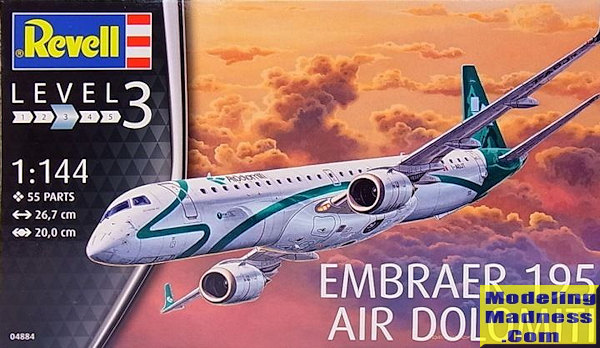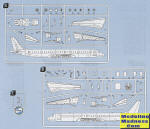Revell 1/144 Embraer 195 'Air Dolomiti'
|
KIT #: |
04884 |
|
PRICE: |
$12.95 SRP |
|
DECALS: |
One option |
|
REVIEWER: |
Scott Van Aken |
|
NOTES: |
New tool kit
(2016) |

The Embraer E-Jet family is a series of narrow-body medium-range
twin-engine jet airliners produced by Brazilian aerospace conglomerate Embraer.
Launched at the Paris Air Show in 1999, and entering production in 2002, the
aircraft series has been a commercial success. The aircraft is used by mainline
and regional airlines around the world. As of 30 September 2015, there is a
backlog of 263 firm orders for the E-Jets, 433 options and 1158 units delivered.
The E190/195 models are a larger stretch of the E170/175 models fitted with a
new, larger wing, larger horizontal stabilizer and a new engine, the GE
CF34-10E, rated at 18,500 lb (82.30 kN). These aircraft compete with the
Bombardier CRJ-1000 and CS100, the Boeing 717-200 and 737-600, and the Airbus
A318. It can carry up to 100 passengers in a two-class configuration or up to
124 in single-class high density configuration.
The first flight of the E190 was on March 12, 2004 (PP-XMA), with the first
flight of the E195 (PP-XMJ) on December 7 of the same year. The launch customer
of the E190 was New York-based low-cost carrier JetBlue with 100 orders options
in 2003 and took its first delivery in 2005. British low-cost carrier Flybe
launched the E195 operations on 22 September 2006. With 14 orders and 12 options
airline was the first operator of this type of aircraft.
As the 190/195 models are of mainline aircraft size, many airlines operate
them as such, fitting them with a business class section and operating them
themselves, instead of having them flown by a regional airline partner. For
example, Air Canada operates 45 E190 aircraft fitted with 9 business-class and
88 economy-class seats as part of its primary fleet. JetBlue and American
Airlines also operate the E190 as part of their own fleet thus allowing airlines
increased crewing flexibility by having the ability of cabin crews to work
aboard narrow-body or widebody aircraft.
 The
other day, I was in the LHS and noticed this one on the shelf. I also noticed
that it was very reasonably priced and since I like Revell airliner kits, I
picked it up. One thing I noticed is that Revell AG has apparently launched a
new look to their boxes. Gone is the blue with stripes box, replaced with one
the boldly states the scale, skill level and other kit stats on the left side of
the box.
The
other day, I was in the LHS and noticed this one on the shelf. I also noticed
that it was very reasonably priced and since I like Revell airliner kits, I
picked it up. One thing I noticed is that Revell AG has apparently launched a
new look to their boxes. Gone is the blue with stripes box, replaced with one
the boldly states the scale, skill level and other kit stats on the left side of
the box.
On the back of the box is an image of the completed kit with close up detail
images, a shot of the sprues, and a series of small rectangles, each with a
color of Revell paint and the Revell paint number inside it. Yes, we still have
to deal with proprietary paint information. On the inside is an all new
instruction sheet on semi-glossy paper and in color to boot. Gone is the
newsprint quality instructions. These instructions are also in booklet form and
stapled in the center. Instructions are still all pictograms and that has not
changed.
The kit itself is molded on two white sprues with a small sprue of clear for the
windscreen. The fuselage halves have open windows over which one will place
decals for the window outlines. I have discovered over the years that modelers
are split regarding having open windows or a solid fuselage where one uses
decals to represent the windows. I prefer the latter as it allows for different
window patterns, but do acknowledge that it is impossible to get the windows
crooked when the are already molded in place.
20 grams of weight are going to be required to keep this one from tail sitting
and while it shows the weight going in front of the nice cockpit piece,
there is no way you'll get that to fit in what is a tiny space. Nose gear well
is molded in the fuselage halves and there is a separate main gear well that
fits into an insert that will be plugged into the underside of the fuselage. I'm
sure this was done to allow for the shorter fuselage kits to be molded and still
use the rest of the tooling.
Wings are molded in upper and lower halves with the upper half containing the
control surfaces and the wing tip. This is the best way to do this sort of
thing. Building up the engines takes a bit and the instructions show the various
parts being painted prior to assembly. I like that the kit provides a single
piece forward engine cowling. This extends back to the engine fan, eliminating
the need to try to fill seams on the inside of the cowling.
Revell provides an in-flight option for those who wish to mount their model on a
stand. No stand is provided, but this shouldn't be an issue for the dedicated.
For gear down, there are nicely molded landing gear and wheels.
 The livery
for this boxing is the Italian airline Air Dolomiti. This is basically an all
white fuselage with light gray wings and stabilizers with metal leading edges.
The scheme is a good choice as there are not a lot of broad decal expanses to
deal with save the tail. For that reason, one should wait to install the tail
planes until after decals have been applied. Perhaps even waiting to glue on the
wings wouldn't be a bad idea either. Decals are properly glossy and the
sheet states they were "designed by Daco and printed in Italy by Revell, a
Hobbico subsidiary".
The livery
for this boxing is the Italian airline Air Dolomiti. This is basically an all
white fuselage with light gray wings and stabilizers with metal leading edges.
The scheme is a good choice as there are not a lot of broad decal expanses to
deal with save the tail. For that reason, one should wait to install the tail
planes until after decals have been applied. Perhaps even waiting to glue on the
wings wouldn't be a bad idea either. Decals are properly glossy and the
sheet states they were "designed by Daco and printed in Italy by Revell, a
Hobbico subsidiary".
A brief web search turned up not only a number of aftermarket decals for
this plane, but the fact that this is not the first 195 kitted. There is at
least one other kit out there that appears to be resin and one from Russia
of undetermined make-up. That Revell decided to do this one indicates that
not only may we see other variants, but other liveries as well. If you like
airliners or just want something a bit different from the norm, I can
recommend this one to you.
https://en.wikipedia.org/wiki/Embraer_E-Jet_family#E-190_and_195
May 2016
Copyright ModelingMadness.com
Thanks to me for picking this one up at the LHS.
If you would like your product reviewed fairly and fairly quickly, please
contact
the editor or see other details in the
Note to
Contributors.
Back to the Main Page
Back to the Review Index Page
Back to the Previews Index Page


 The
other day, I was in the LHS and noticed this one on the shelf. I also noticed
that it was very reasonably priced and since I like Revell airliner kits, I
picked it up. One thing I noticed is that Revell AG has apparently launched a
new look to their boxes. Gone is the blue with stripes box, replaced with one
the boldly states the scale, skill level and other kit stats on the left side of
the box.
The
other day, I was in the LHS and noticed this one on the shelf. I also noticed
that it was very reasonably priced and since I like Revell airliner kits, I
picked it up. One thing I noticed is that Revell AG has apparently launched a
new look to their boxes. Gone is the blue with stripes box, replaced with one
the boldly states the scale, skill level and other kit stats on the left side of
the box.  The livery
for this boxing is the Italian airline Air Dolomiti. This is basically an all
white fuselage with light gray wings and stabilizers with metal leading edges.
The scheme is a good choice as there are not a lot of broad decal expanses to
deal with save the tail. For that reason, one should wait to install the tail
planes until after decals have been applied. Perhaps even waiting to glue on the
wings wouldn't be a bad idea either. Decals are properly glossy and the
sheet states they were "designed by Daco and printed in Italy by Revell, a
Hobbico subsidiary".
The livery
for this boxing is the Italian airline Air Dolomiti. This is basically an all
white fuselage with light gray wings and stabilizers with metal leading edges.
The scheme is a good choice as there are not a lot of broad decal expanses to
deal with save the tail. For that reason, one should wait to install the tail
planes until after decals have been applied. Perhaps even waiting to glue on the
wings wouldn't be a bad idea either. Decals are properly glossy and the
sheet states they were "designed by Daco and printed in Italy by Revell, a
Hobbico subsidiary".